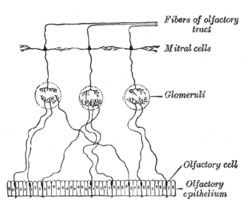| Mitral cell | |
|---|---|
 Coronal section of olfactory bulb. | |
 Plan of olfactory neurons. | |
| Details | |
| System | Smell |
| Location | Olfactory bulb of mammals |
| Identifiers | |
| NeuroLex ID | nifext_120 |
| Anatomical terms of neuroanatomy | |
Mitral cells are neurons that are part of the olfactory system. They are located in the olfactory bulb in the mammalian central nervous system. They receive information from the axons of olfactory receptor neurons, forming synapses in neuropils called glomeruli. Axons of the mitral cells transfer information to a number of areas in the brain, including the piriform cortex, entorhinal cortex, and amygdala. Mitral cells receive excitatory input from olfactory sensory neurons and external tufted cells on their primary dendrites, whereas inhibitory input arises either from granule cells onto their lateral dendrites and soma or from periglomerular cells onto their dendritic tuft. Mitral cells together with tufted cells form an obligatory relay for all olfactory information entering from the olfactory nerve. Mitral cell output is not a passive reflection of their input from the olfactory nerve. In mice, each mitral cell sends a single primary dendrite into a glomerulus receiving input from a population of olfactory sensory neurons expressing identical olfactory receptor proteins, yet the odor responsiveness of the 20-40 mitral cells connected to a single glomerulus (called sister mitral cells)[1] is not identical to the tuning curve of the input cells, and also differs between sister mitral cells.[2] Odorant response properties of individual neurons in an olfactory glomerular module. The exact type of processing that mitral cells perform with their inputs is still a matter of controversy. One prominent hypothesis is that mitral cells encode the strength of an olfactory input into their firing phases relative to the sniff cycle. A second hypothesis is that the olfactory bulb network acts as a dynamical system that decorrelates to differentiate between representations of highly similar odorants over time. Support for the second hypothesis comes primarily from research in zebrafish (where mitral and tufted cells cannot be distinguished).[3]
- ^ Dhawale, A (November 2010). "Non-redundant odor coding by sister mitral cells revealed by light addressable glomeruli in the mouse". Nat. Neurosci. 13 (11): 1404–12. doi:10.1038/nn.2673. PMC 3208311. PMID 20953197.
- ^ Kikuta, S (March 2013). "Odorant response properties of individual neurons in an olfactory glomerular module". Neuron. 77 (6): 1122–35. doi:10.1016/j.neuron.2013.01.022. PMC 3607817. PMID 23522047.
- ^ Friedrich, R (February 2001). "Dynamic optimization of odor representations by slow temporal patterning of mitral cell activity". Science. 291 (5505): 889–94. Bibcode:2001Sci...291..889F. doi:10.1126/science.291.5505.889. PMID 11157170.